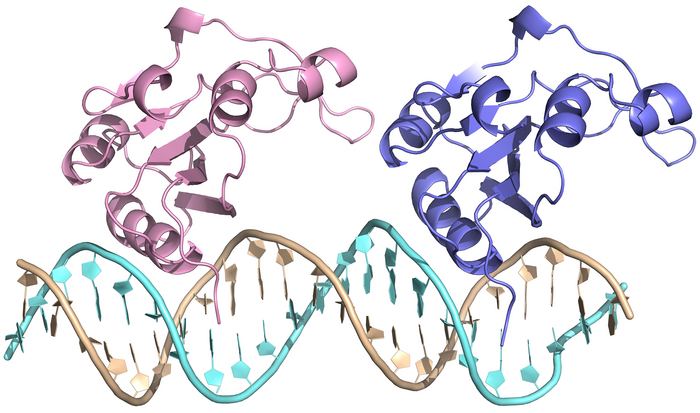
Credit: IRB Barcelona
- Plasmids, small circular DNA molecules found in bacteria, may contain antibiotic-resistance genes and have the ability to replicate independently.
- Bacteria can transfer these plasmids to one another, thus spreading antibiotic resistance, a serious global health problem.
- Researchers at IRB Barcelona publish the structure of the RepB protein bound to DNA, a key protein in triggering the replication of plasmid pMV158, in the journal Nucleic Acids Research.
In all living organisms, DNA replication is essential to ensure the genetic fidelity of the next generation. However, bacteria can also transfer genetic information horizontally to other bacteria. Many species of pathogenic bacteria have transmissible antibiotic resistance plasmids, which are often reproduced through a rolling circle replication machinery. Plasmid pMV158, which is present in the genus Streptococcus, belongs to this group. This plasmid determines resistance to tetracycline and its replication is initiated by the RepB protein.
Scientists led by Dr. Miquel Coll at the Institute for Research in Biomedicine (IRB Barcelona) and the Institute of Molecular Biology of Barcelona (IBMB-CSIC), and Dr. Gloria del Solar, at the Center for Biological Research (CIB-CSIC), have discovered a new hexameric structure of the RepB protein and how it binds to DNA. The study has involved biochemical and X-ray crystallography techniques. This structure points to a high degree of flexibility, which is attributed to the capacity of this protein to carry out a dual function, that is, to bind to two distinct positions of the plasmid and cut one of the DNA strands to separate it, thereby initiating replication.
“In general, few resources are devoted to the development of new antibiotics and greater efforts should be made in this regard. It’s also crucial to determine how resistance to antibiotics occurs and how it’s propagated,” says Dr. Coll, head of the Structural Biology of Protein & Nucleic Acid Complexes and Molecular Machines lab at IRB Barcelona and professor at the CSIC. “This plasmid is also promiscuous, meaning that it is transferred between different bacterial species and, as a result, resistance to the antibiotic spreads,” he adds.
A growing medical concern
Antibiotics are medicines and, since their discovery, they have saved millions of lives. However, their indiscriminate use has caused the emergence of resistance and the rapid spread of bacteria carrying plasmids with resistance genes. These resistant bacteria have become a very serious problem, particularly in hospitals—settings in which a large number of antibiotics are used and vulnerable patients are found.
“The massive use of antibiotics, both in humans and livestock, has led to growing resistance to them. Nosocomial infections, that is, those that occur in hospitals and that the patient did not have when admitted, affect 7% of patients and are difficult to treat due to the current resistance to antibiotics,” adds Dr. Coll.
The first authors of the study are Dr. Cristina Machón, from IRB Barcelona, and Dr. José A Ruiz-Masó, from CIB-CSIC. The project has had the collaboration of the Automated Crystallography Platform at the IBMB and IRB Barcelona, and the X-ray data were gathered at the Alba (Barcelona, Spain) and ESRF (Grenoble, France) synchrotrons.
The study was funded by the Ministry of Science and Innovation.
Related article
Structures of pMV158 replication initiator RepB with and without DNA reveal a flexible dual-function protein
Cristina Machón, José A Ruiz-Masó, Juliana Amodio, D Roeland Boer, Lorena Bordanaba-Ruiseco, Katarzyna Bury, Igor Konieczny, Gloria del Solar & Miquel Coll
Nucleic Acids Research (2023), DOI: https://doi.org/10.1093/nar/gkac1271
Journal
Nucleic Acids Research
DOI
10.1093/nar/gkac1271
Method of Research
Experimental study
Subject of Research
Cells
Article Title
Structures of pMV158 replication initiator RepB with and without DNA reveal a flexible dual-function protein
Article Publication Date
23-Jan-2023




